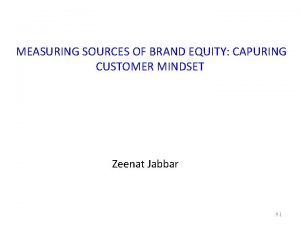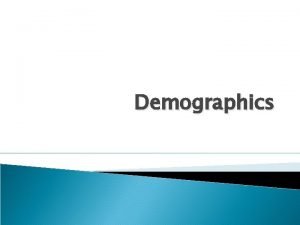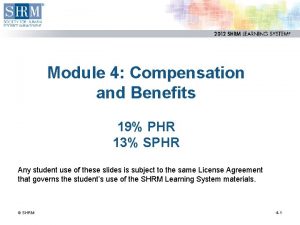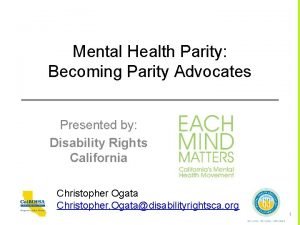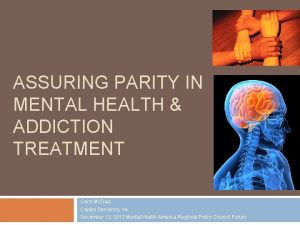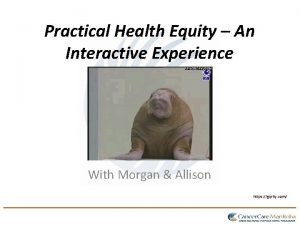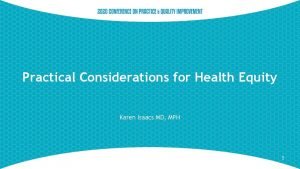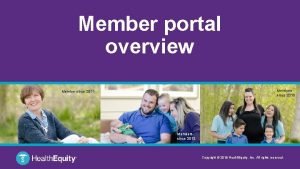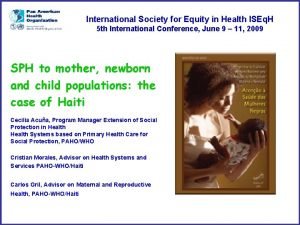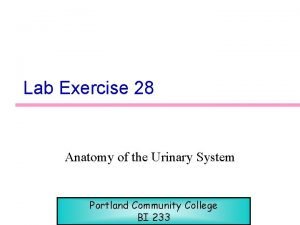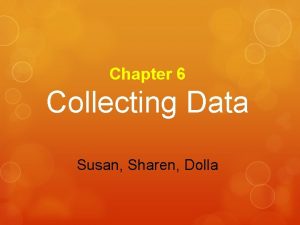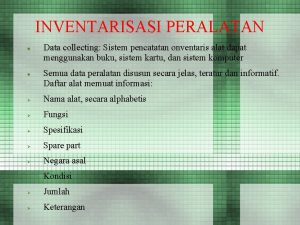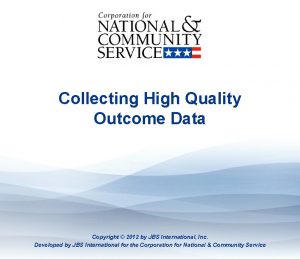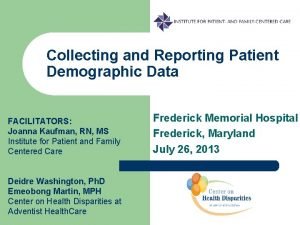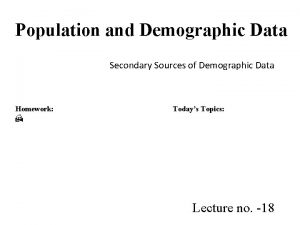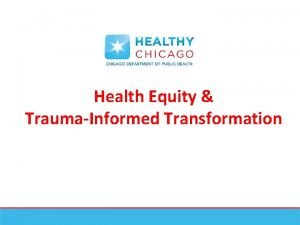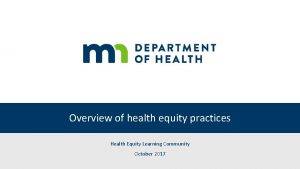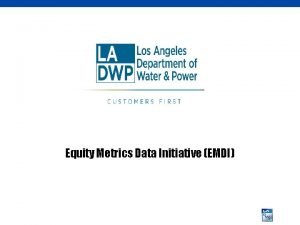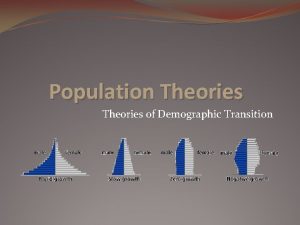Measuring Health Equity Collecting PatientClient Demographic Data in
![Measuring Health Equity: Collecting Patient/Client Demographic Data in TC LHIN [Organization Name] [Date] Acknowledgement: Measuring Health Equity: Collecting Patient/Client Demographic Data in TC LHIN [Organization Name] [Date] Acknowledgement:](https://slidetodoc.com/presentation_image_h2/ab9b00c85d8b92be1c837a3988ad8001/image-1.jpg)



































![Contact Information • For more information/support: [insert name of key contact person] • Or Contact Information • For more information/support: [insert name of key contact person] • Or](https://slidetodoc.com/presentation_image_h2/ab9b00c85d8b92be1c837a3988ad8001/image-37.jpg)






- Slides: 43
![Measuring Health Equity Collecting PatientClient Demographic Data in TC LHIN Organization Name Date Acknowledgement Measuring Health Equity: Collecting Patient/Client Demographic Data in TC LHIN [Organization Name] [Date] Acknowledgement:](https://slidetodoc.com/presentation_image_h2/ab9b00c85d8b92be1c837a3988ad8001/image-1.jpg)
Measuring Health Equity: Collecting Patient/Client Demographic Data in TC LHIN [Organization Name] [Date] Acknowledgement: Adapted from “Measuring Health Equity in TC LHIN” Training Model. Developed by Human Rights & Health Equity Office, Sinai Health System. With support from Toronto Central LHIN. More at torontohealthequity. ca

Agenda • • Introduction, Ground Rules, Learning Outcomes Understanding Health Equity The 8 TC LHIN Questions Demographic Data Collection: – Best practices – Overcoming Data Collection Challenges – Data Collection Process • Role Playing Scenarios • Next Steps & Evaluation

Ground Rules • Listen carefully • Speak from your own experience- e. g. “I think” rather than “everyone knows” • No personal attacks - challenge the perspective, not the individual • Ask for clarification when needed • Put devices on silent function

What we want to accomplish today 1. Develop knowledge of health equity principles 2. Become familiar with the TC LHIN questions 3. Understand best practices and approaches for asking demographic questions

Statistics Activity Learning about Health Inequities… • Please walk around the room, read the statistics on the wall, and then stand beside the statistic that most affects, surprises or interests you… • We will then spend a few minutes sharing

Measuring Health Equity Video

What is health equity? • “Health equity is the ideal state in which all people are able to reach their full health potential and receive high quality care that is fair and appropriate from each persons perspective, no matter where they live, who they are, or what they have. ” – Health Quality Ontario, 2016 • Equal care ≠ Equitable care

Using patient/client demographic data… System Level Organization Level Individual Level Understand patient/client needs Identify who is being served, report + address inequities Fund and plan for equitable health care

TC LHIN 8 Core Questions Language Born in Canada Racial or Ethnic Group Disability Gender Sexual Orientation Income #Ppl income supports What language would you feel most comfortable speaking in with your health-care provider? Were you born in Canada? Which of the following best describes your racial or ethnic group? Do you have any of the following? What is your gender? What is your sexual orientation? What was your totally family income before taxes last year? How many people does this income support?

Hospital Patient Responses (~124, 000): “Prefer Not to Answer” or “Do not know” Language 0, 2% Born in Canada 0, 9% Racial/Ethnic Group 7, 4% Disability 5, 1% Gender* 5, 9% Sexual orientation 8, 4% Income 34, 7% # supported by income 21, 5% 0% 5% * ‘missing data’ not included 10% 15% 20% 25% 30% 35% 40% 45%

CHC Clients Responding “Prefer not to answer”, “Do not know” and Missing Data Racial/Ethnic group 3, 5% 9, 1% Disability Gender 7, 3% 1, 2% 15, 2% Prefer not to answer/Do not know 6, 6% Missing Sexual Orientation 0, 0% 10, 6% 5, 0% 15, 2% 10, 0% 15, 0% 20, 0% 25, 0% 30, 0%

Video - Asking the 8 Questions • What did you like about the interaction between the staff member and patient/client? • What do you think could have been done better?

KEY MESSAGES These questions will tell us who our patients/clients are This will take a few minutes. It’s completely voluntary, so you can choose ‘prefer not to answer’ to any of questions. It will help us improve services and ensure quality care Your information will be kept confidential and will only be available to people taking care of you here.

8 TC LHIN Questions: What they mean, Why we collect them

LANGUAGE 1. What language would you feel most comfortable speaking in with your health-care provider? Check ONE only *33 response options based on the list of most interpreted languages in TC LHIN, in addition to: Other (Please specify) Prefer not to answer Do not know Why do you want to know? “It’s helpful for us to know because… … we can use this information to provide interpreters”

BORN IN CANADA 2. Were you born in Canada? YES NO Prefer not to answer Do not know If NO, what year did you arrive in Canada? _____ Why do you want to know? “It’s helpful for us to know because… … this information will help us understand the health care experiences of newcomers to Canada- e. g. what types of supports would be helpful? ”

RACIAL/ETHNIC GROUP 3. Which of the following best describes your racial or ethnic group? Check ONE only *15 response options, in addition to: Mixed heritage (Please specify) Other (Please specify) Prefer not to answer Do not know Why do you want to know? “It’s helpful for us to know because… … this can provide information on patient/client diets or need for genetic testing” … we can use this data to reach out to vulnerable groups we know get less screening tests- e. g. cancer screening”

DISABILITY 4. Do you have any of the following? Check ALL that apply Chronic illness Developmental disability Drug or alcohol dependence Learning disability Mental illness Physical disability Sensory disability Other (Please specify) None Prefer not to answer Do not know Why do you want to know? “It’s helpful for us to know because… …knowing the types of accommodation we need will help us provide and plan for better care”


GENDER 5. What is your gender? Check ONE only Female Other (Please specify) Intersex Prefer not to answer Male Do not know Trans- Female to Male Trans- Male to Female Why do you want to know? “It’s helpful for us to know because… … it provides information we need for things such as room assignment or types of tests to plan for (e. g. pap smear, blood test interpretation, …) … we can use this data to understand the health care experiences of vulnerable groups such as trans patients/clients”

SEXUAL ORIENTATION 6. What is your sexual orientation? Check ONE only Bisexual Two-Spirit Gay Other (Please specify) Heterosexual (“straight”) Prefer not to answer Lesbian Do not know Queer Why do you want to know? “It’s helpful for us to know because… … we can look at this data to ensure that all patients/clients are getting the best care possible” … we don’t want to assume patients’ /clients’ sexual orientation when we provide them with care”

INCOME (HOSPITAL) 7. What was your total family income before taxes last year? Check ONE only $0 - $29, 999 $120, 000 - $149, 999 $30, 000 - $59, 999 $150, 000 or more $60, 000 - $89, 999 Prefer not to answer $90, 000 - $119, 999 Do not know 8. How many people does this income support? ____ person(s) Prefer not to answer Do not know Why do you want to know? “It’s helpful for us to know because… … we want to understand the link between income and health care” … information on how much a patient /client makes could be relevant to medical prescriptions or ability for patient/client to follow directions (e. g. access to a refrigerator) or ability to make it to the hospital/CHC”

INCOME (CHC) Why do you want to know? “It’s helpful for us to know because… … we want to understand the link between income and health care” … information on how much a patient /client makes could be relevant to medical prescriptions or ability for patient/client to follow directions (e. g. access to a refrigerator) or ability to make it to the hospital/CHC”

Collecting Demographic Data

3 key messages to share Why? Voluntary Who will see the information? • We are collecting social information from patients /clients to find out who we serve and what unique needs our patients/clients have. • We will also use this information to understand patient/client experiences and outcomes. • The questions are voluntary and you can choose ‘prefer not to answer’ to any or all questions. • This will not affect your care. • This information will be accessible only to the health care team taking care of you • If used in research, information will be combined with data from all other patients/clients and no one will be able to identify any patient/client.

Additional reminders (HOSPITAL)… • 8 core questions available in 11 languages • TC LHIN Pediatric guidelines

Additional reminders (CHC)… • 8 core questions available in 11 languages • TC LHIN Children & Youth guidelines

Workflow: Paper-based Collection 1. Giving out form • Introduce questions using 3 key message points: – Purpose – Voluntary – Confidentiality • Hand out form and brochure • Remind client to return form: – Highlight “return even if you didn’t complete it all” • Let client know available to answer any questions 2. Collecting form • Follow up to ensure client returns the form • Double-check missing data – Blank form: Confirm with client ‘prefer not to answer’ to all questions – Missing questions: • Say “I noticed question (#) is blank, do you have any questions? ” • Inform client of answer options for ‘prefer not to answer’ or ‘do not know’

Data Quality • There are no ‘wrong’ responses • Missing data should be as close to 0% as possible 1. Ensure patient/client returns form 2. Ensure patient/client has responded to all items • Addressing patient/client questions is key to good data If entering data: • Enter responses verbatim, word for word – Do not move responses into other categories • Bring up data quality issues with supervisor

Takeaway Points ü Patients and clients are willing to share this information ü Some patients and clients are likely to have experienced discrimination and harassment and may be reluctant to answer questions ü Best Practice: Data collection should include follow-up/interaction with patient/client ü The approach of the data collector is the best predictor of patient and client engagement ü Embed data collection into ongoing practices

Resources Available Patient /Client brochure Laminated Questions Posters Translations Glossary of Terms E-learning Cheat Sheet Manual

Practice

Asking the 8 Core Demographic Questions • What did you like about the interaction between the staff member and patient/client? • What do you think could have been done differently or better?

Practice session • Optional demo- ‘patient/client’ volunteer needed • Form groups of 2: Patient/Client, Staff, Observer • Review practice exercise This is a chance to practice: • introducing/presenting the Demographic Data Form • answering any questions or responding to any concerns patients/clients may present

Practice Introducing the form…. We are collecting information to tells us who our patients/clients are The questions are voluntary Your responses will be protected and stored with your health-care information

Wrap-up Your input, Evaluation, Questions?
![Contact Information For more informationsupport insert name of key contact person Or Contact Information • For more information/support: [insert name of key contact person] • Or](https://slidetodoc.com/presentation_image_h2/ab9b00c85d8b92be1c837a3988ad8001/image-37.jpg)
Contact Information • For more information/support: [insert name of key contact person] • Or visit www. torontohealthequity. ca

Additional Trainer Materials

Demographic Data Use LANGUAGE Uses in care § To provide appropriate care delivery as required by the Charter of Rights and Freedoms § To acquire informed consent Uses in planning § To improve access to care for those who do not speak/ready English or French Impact on quality § Use of interpreters and translators has direct impact on quality and safety BORN IN CANADA Uses in care § To address barriers and stress associated with migration and settlement Uses in planning § To understand the types of supports or services needed Impact on quality § Improve access to care for newcomers to Canada

Demographic Data Use RACIAL/ETHNIC GROUP Uses in care § To provide targeted care and supports (e. g. Middle Eastern populations & thalassemia, …) Uses in planning § To improve outreach to vulnerable groups who do not seek care at the same level as other groups § To address access challenges Impact on quality § Outreach improves preventative care and reduces admissions DISABILITY Uses in care § To fulfill organizational responsibilities around providing accommodation § Address histories of traumatic interactions Uses in planning § To carry out accommodation planning § To work on preventing recurrence of exclusion Impact on quality § Better accommodation leads to more efficient and effective care

Demographic Data Use GENDER Uses in care § Both sex and gender are relevant to essential medical testing (e. g. hormone levels, pap smears) § To accommodate the unique needs related to patients’/clients’ gender identity Uses in planning § To improve outreach to vulnerable groups who do not access care at the same level as other groups Impact on quality § Better planning improves preventative care and health outcomes SEXUAL ORIENTATION Uses in care § To understand the needs of patients/clients (e. g. living with discrimination) Uses in planning § To create welcoming environments for LGB community members § To identify LGB friendly community partners Impact on quality § Providing a welcoming environment improves access and patient/client experiences

Demographic Data Use INCOME Uses in care § Relevant for medical prescriptions Uses in planning § To ameliorate the impact of income on access to primary and preventative health-care Impact on quality § Improved health-care for all

Measuring Health Equity Videos http: //torontohealthequity. ca/training/videos/ Overview Video Gender (hospitals) Racial/ethnic group (CHCs) Race & Religion (hospitals) Asking the 8 Core Demographic Questions (Hospitals) Sexual orientation (CHCs) Income (hospitals) Disability (hospitals) Asking the 8 Core Demographic Questions (CHCs) Asking the 12 Demographic Questions (Hospitals)
 Qualitative research techniques to measure brand equity
Qualitative research techniques to measure brand equity Brand based comparative approach
Brand based comparative approach Qualitative research techniques to measure brand equity
Qualitative research techniques to measure brand equity Collecting highly parallel data for paraphrase evaluation
Collecting highly parallel data for paraphrase evaluation Collecting and displaying data
Collecting and displaying data Samples of collecting engineering data
Samples of collecting engineering data Population demography definition
Population demography definition Source of demographic data
Source of demographic data Wageworks health equity
Wageworks health equity Mental health equity
Mental health equity Mental health equity
Mental health equity Health equity customer service
Health equity customer service Mental health equity
Mental health equity Health equity
Health equity Health equity
Health equity Health equity member portal
Health equity member portal International society for equity in health
International society for equity in health Health equity
Health equity Electromagnetic waves vocabulary
Electromagnetic waves vocabulary Transport maximum
Transport maximum Ductnn
Ductnn Transversus abdominis
Transversus abdominis Maths bot.com
Maths bot.com Coupon collecting problem
Coupon collecting problem Collecting gas over water
Collecting gas over water Chapter 34 collecting and testing specimens
Chapter 34 collecting and testing specimens The lymphatic capillaries are
The lymphatic capillaries are Collecting gas over water
Collecting gas over water Rutherford stamp collecting
Rutherford stamp collecting Coin collecting workshop
Coin collecting workshop Collecting a gas over water
Collecting a gas over water Dr frost collecting like terms
Dr frost collecting like terms Prize collecting steiner tree
Prize collecting steiner tree Collection of cheques
Collection of cheques Collecting information and forecasting demand
Collecting information and forecasting demand Tag questions simple present
Tag questions simple present Lung tissue
Lung tissue Collecting ducts
Collecting ducts Collecting duct meaning
Collecting duct meaning Selective reabsorption in the proximal convoluted tubule
Selective reabsorption in the proximal convoluted tubule Collecting ducts
Collecting ducts Peritubular capillaries vs vasa recta
Peritubular capillaries vs vasa recta Nitrogenous waste
Nitrogenous waste Kidney
Kidney


